Transient receptor potential vanilloid subtype 1 channel mediated neuropeptide secretion and depressor effects: role of endoplasmic reticulum associated Ca2+ release receptors in rat dorsal root ganglion neurons
- PMID: 18806620
- PMCID: PMC2669742
- DOI: 10.1097/HJH.0b013e328309eff9
Transient receptor potential vanilloid subtype 1 channel mediated neuropeptide secretion and depressor effects: role of endoplasmic reticulum associated Ca2+ release receptors in rat dorsal root ganglion neurons
Abstract
Objective: This study tests the hypothesis that the transient receptor potential vanilloid subtype 1 channel induced neuropeptide secretion and depressor response are mediated by, at least in part, activation of endoplasmic reticulum associated Ca release receptors, leading to increased cytosolic Ca in dorsal root ganglion neurons.
Methods/results: Bolus injection of capsaicin (10 or 50 microg/kg), a selective transient receptor potential vanilloid subtype 1 channel agonist, into anesthetized male Wistar rats caused a dose-dependent decrease in mean arterial pressure (P < 0.05). Capsaicin (50 microg/kg)-induced depressor effects and increase in plasma calcitonin gene related peptide (CGRP) levels (-29 +/- 2 mmHg, 82.2 +/- 5.0 pg/ml) were abolished by a selective transient receptor potential vanilloid subtype 1 channel antagonist, capsazepine (3 mg/kg, -4 +/- 1 mmHg, 41.8 +/- 4.4 pg/ml, P < 0.01), and attenuated by a selective ryanodine receptor antagonist, dantrolene (5 mg/kg, -12 +/- 1 mmHg, 57.2 +/- 2.6 pg/ml, P < 0.01), but unaffected by an inhibitor of endoplasmic reticulum Ca-ATPase, thapsigargin (50 microg/kg, -30 +/- 1 mmHg, 73.8 +/- 2.3 pg/ml, P > 0.05), or an antagonist of the inositol (1,4,5)-trisphosphate receptor, 2-aminoethoxydiphenyl borate (3 mg/kg, -34 +/- 5 mmHg, 69.0 +/- 3.7 pg/ml, P > 0.05). CGRP8-37 (1 mg/kg), a selective CGRP receptor antagonist, also blocked capsaicin-induced depressor effects. In contrast, dantrolene had no effect on CGRP (1 microg/kg)-induced depressor effects. In vitro, capsaicin (0.3 micromol/l) increased intracellular Ca concentrations and CGRP release from freshly isolated sensory neurons in dorsal root ganglion (P < 0.01), which were blocked by capsazepine (10 micromol/l) and attenuated by dantrolene but not thapsigargin or 2-aminoethoxydiphenyl borate.
Conclusion: Our results indicate that transient receptor potential vanilloid subtype 1 channel activation triggers ryanodine receptor but not inositol (1,4,5)-trisphosphate receptor dependent Ca release from endoplasmic reticulum in dorsal root ganglion neurons, leading to increased CGRP release and consequent depressor effects.
Figures
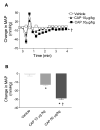
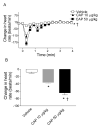
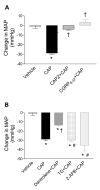
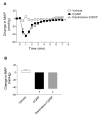
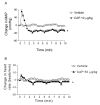
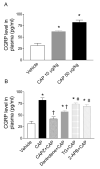

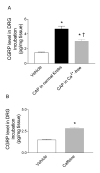


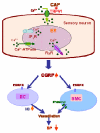
Similar articles
-
Interdependent regulation of afferent renal nerve activity and renal function: role of transient receptor potential vanilloid type 1, neurokinin 1, and calcitonin gene-related peptide receptors.J Pharmacol Exp Ther. 2008 Jun;325(3):751-7. doi: 10.1124/jpet.108.136374. Epub 2008 Mar 25. J Pharmacol Exp Ther. 2008. PMID: 18364471 Free PMC article.
-
Hypotension induced by activation of the transient receptor potential vanilloid 4 channels: role of Ca2+-activated K+ channels and sensory nerves.J Hypertens. 2010 Jan;28(1):102-10. doi: 10.1097/HJH.0b013e328332b865. J Hypertens. 2010. PMID: 19996988 Free PMC article.
-
Increased depressor response to N-arachidonoyl-dopamine during high salt intake: role of the TRPV1 receptor.J Hypertens. 2007 Dec;25(12):2426-33. doi: 10.1097/HJH.0b013e3282efd1bf. J Hypertens. 2007. PMID: 17984664
-
Versatile regulation of cytosolic Ca2+ by vanilloid receptor I in rat dorsal root ganglion neurons.J Biol Chem. 2003 Feb 14;278(7):5462-72. doi: 10.1074/jbc.M209111200. Epub 2002 Nov 25. J Biol Chem. 2003. PMID: 12454015
-
The activation of transient receptor potential vanilloid receptor subtype 1 by capsaicin without extracellular Ca2+ is involved in the mechanism of distinct substance P release in cultured rat dorsal root ganglion neurons.Naunyn Schmiedebergs Arch Pharmacol. 2008 Jun;377(4-6):325-32. doi: 10.1007/s00210-007-0211-5. Epub 2007 Nov 23. Naunyn Schmiedebergs Arch Pharmacol. 2008. PMID: 18034335
Cited by
-
Potential Role of Yoga Intervention in the Management of Chronic Non-malignant Pain.Evid Based Complement Alternat Med. 2022 May 28;2022:5448671. doi: 10.1155/2022/5448671. eCollection 2022. Evid Based Complement Alternat Med. 2022. PMID: 35668780 Free PMC article. Review.
-
Calcium Signalling in Breast Cancer Associated Bone Pain.Int J Mol Sci. 2022 Feb 8;23(3):1902. doi: 10.3390/ijms23031902. Int J Mol Sci. 2022. PMID: 35163823 Free PMC article. Review.
-
Endothelial TRPV1 as an Emerging Molecular Target to Promote Therapeutic Angiogenesis.Cells. 2020 May 27;9(6):1341. doi: 10.3390/cells9061341. Cells. 2020. PMID: 32471282 Free PMC article. Review.
-
Acute effect of different concentrations of cayenne pepper cataplasm on sensory-motor functions and serum levels of inflammation-related biomarkers in healthy subjects.Eur J Transl Myol. 2018 Mar 1;28(1):7333. doi: 10.4081/ejtm.2018.7333. eCollection 2018 Jan 12. Eur J Transl Myol. 2018. PMID: 29686821 Free PMC article.
-
Alterations in the neural circuits from peripheral afferents to the spinal cord: possible implications for diabetic polyneuropathy in streptozotocin-induced type 1 diabetic rats.Front Neural Circuits. 2014 Jan 29;8:6. doi: 10.3389/fncir.2014.00006. eCollection 2014. Front Neural Circuits. 2014. PMID: 24523675 Free PMC article.
References
-
- Szalasi A, Blumberg PM. Vanilloid (Capsaicin) receptors and mechanisms. Pharmacol Rev. 1999;51:159–212. - PubMed
-
- Julius D, Basbaum AI. Molecular mechanisms of nociception. Nature. 2001;413:203–210. - PubMed
-
- Zygmunt PM, Petersson J, Andersson DA, Chuang H, Sorgard M, Di Marzo V, Julius D, Hogestatt ED. Vanilloid receptors on sensory nerves mediate the vasodilator action of anadamide. Nature. 1999;400:452–457. - PubMed
-
- Li J, Kaminski NE, Wang DH. Anadamide-induced depressor effect in spontaneously hypertensive rats: role of the vanilloid receptor. Hypertension. 2003;41:757–762. - PubMed
-
- Brian SD, Grant AD. Vascular actions of calcitonin gene-related peptide and adrenomedullin. Physiology Review. 2004;84:903–934. - PubMed
Publication types
MeSH terms
Substances
Grants and funding
- R01 HL057853-06/HL/NHLBI NIH HHS/United States
- HL-73287/HL/NHLBI NIH HHS/United States
- R01 HL073287/HL/NHLBI NIH HHS/United States
- R01 DK067620/DK/NIDDK NIH HHS/United States
- R01 HL073287-04/HL/NHLBI NIH HHS/United States
- R01 HL057853/HL/NHLBI NIH HHS/United States
- DK67620/DK/NIDDK NIH HHS/United States
- R01 DK067620-04/DK/NIDDK NIH HHS/United States
- HL-57853/HL/NHLBI NIH HHS/United States
- R01 HL073287-05/HL/NHLBI NIH HHS/United States
- R01 HL057853-07/HL/NHLBI NIH HHS/United States
- R01 DK067620-03/DK/NIDDK NIH HHS/United States
LinkOut - more resources
Full Text Sources
Research Materials
Miscellaneous

